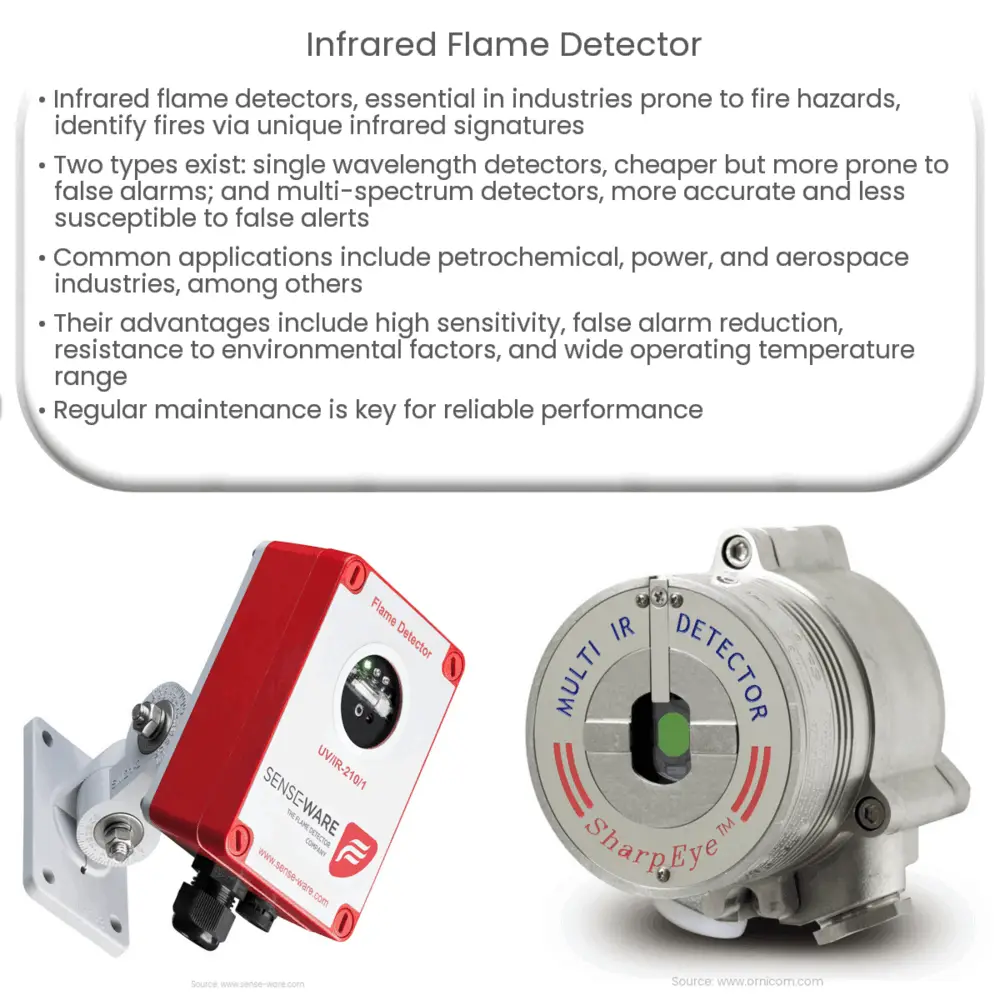Infrared flame detectors are safety devices that detect fires using infrared radiation, offering high sensitivity, reduced false alarms, and resistance to environmental factors.

Infrared Flame Detectors: Understanding the Basics and Applications
Introduction to Infrared Flame Detectors
Infrared flame detectors are essential safety devices that monitor and detect flames using the infrared spectral band. These sophisticated devices have become increasingly popular in industries where fire hazards are prevalent, such as petrochemical, power generation, and aerospace. This article will delve into the fundamental principles behind infrared flame detectors, their types, applications, and advantages over other flame detection technologies.
How Infrared Flame Detectors Work
At the core of an infrared flame detector is its ability to detect the infrared radiation emitted by a flame. When a fire ignites, it releases energy in the form of heat and light. This energy consists of various wavelengths, including infrared radiation. Infrared flame detectors are specifically designed to identify the unique infrared signatures of flames, enabling them to accurately detect fires.
These detectors typically consist of an infrared sensor, a filter, and processing electronics. The infrared sensor is sensitive to the specific wavelength range associated with flames, while the filter helps to eliminate interference from ambient light and other non-flame sources of radiation. The processing electronics analyze the incoming signal and determine if a flame is present based on the detected infrared signature.
Types of Infrared Flame Detectors
There are two primary types of infrared flame detectors: single wavelength and multi-spectrum. Each type has its advantages and is suited to different applications.
1. Single Wavelength Infrared Detectors
Single wavelength infrared detectors are designed to detect infrared radiation within a specific, narrow wavelength range. They are typically more affordable and straightforward in design compared to multi-spectrum detectors. However, their sensitivity to a limited range of wavelengths can make them more susceptible to false alarms caused by non-flame sources of radiation, such as hot surfaces or sunlight.
2. Multi-Spectrum Infrared Detectors
Multi-spectrum infrared detectors are capable of detecting multiple wavelengths within the infrared spectrum. This broader sensitivity enables them to identify the unique infrared signatures of different types of flames, making them more accurate and less prone to false alarms. Multi-spectrum detectors are well-suited for demanding environments where various flame sources and potential sources of interference may be present.
Applications of Infrared Flame Detectors
Infrared flame detectors are utilized in a wide range of industries and applications to ensure safety and prevent potential disasters. Some common applications include:
- Petrochemical facilities
- Power plants and substations
- Aerospace and aviation facilities
- Industrial manufacturing plants
- Offshore oil and gas platforms
- Warehouses and storage facilities
Advantages of Infrared Flame Detectors
Infrared flame detectors offer several benefits over other flame detection technologies, such as ultraviolet (UV) and ionization detectors. Some of the key advantages include:
- High sensitivity: Infrared detectors can detect flames at greater distances than other technologies, ensuring early detection and faster response times.
- False alarm reduction: Multi-spectrum infrared detectors are less prone to false alarms caused by non-flame sources of radiation, such as sunlight, hot surfaces, or electrical discharges.
- Resistance to environmental factors: Infrared detectors are not affected by smoke, dust, or steam, making them suitable for use in harsh industrial environments.
- Wide operating temperature range: Infrared detectors can function effectively across a broad range of temperatures, further enhancing their versatility.
Maintenance and Testing of Infrared Flame Detectors
Regular maintenance and testing are crucial to ensuring the reliable performance of infrared flame detectors. Some essential maintenance and testing practices include:
- Visual inspection: Regularly inspect the detector housing and lens for any signs of damage or contamination that could impair its function.
- Cleaning: Periodically clean the detector lens with a soft cloth or lens cleaner to remove dust, dirt, and other debris that may affect its sensitivity.
- Functional testing: Perform functional tests using an approved infrared test lamp to confirm the detector’s ability to detect and respond to a flame.
- Calibration: Regularly calibrate the detector according to the manufacturer’s recommendations to ensure accurate and reliable performance.
Conclusion
Infrared flame detectors are indispensable tools for enhancing safety in various industries where fire hazards are a constant concern. With their high sensitivity, resistance to environmental factors, and reduced false alarms, these detectors provide an effective means of detecting and responding to fires. By understanding the underlying principles, types, and applications of infrared flame detectors, as well as their advantages over other flame detection technologies, professionals in industries prone to fire hazards can make informed decisions about implementing the most suitable detection systems for their specific needs. Regular maintenance and testing further ensure that these detectors continue to operate reliably and effectively, safeguarding lives and property from the devastating consequences of fires.

